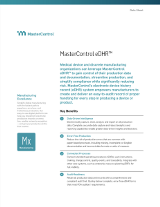
GxP Lifeline
4 Tech Trends to Watch in Manufacturing Device History Records
While recent and ongoing advances in big data, the internet of things (IoT), cloud computing and other technologies have affected medical device manufacturing in a profound way, manufacturers are still trying to understand exactly how and where to apply digital technology to achieve better operational and quality results.
The constant evolution of digital technology means medical device manufacturers should keep a close eye on changes in automation and be agile to respond to these developments.
A new white paper examines technology-heavy manufacturing trends that the medical device industry can expect in the coming year, particularly as they relate to device history records (DHRs).
Trend #1: Paperless Initiatives on the Shop Floor
In a recent survey of manufacturing executives, a majority of respondents said they use pen and paper to track critical manufacturing steps, while 50 percent reported using spreadsheets or a computer on wheels – but by 2022, paper-based processes are forecast to decline from 62 percent to 21 percent. As more companies recognize the benefits of going paperless and even declare it a corporate directive, they will reshape how production processes are managed and how production records are maintained on the shop floor.
Eliminating paper and moving to an electronic DHR (eDHR) system would enable automatic collection of required production details, compiled in a compliant and consistent format according to CGMP and other requirements, and facilitate real-time data checks to ensure the information is complete and in the correct format. An eDHR software can help manufacturers track all entered information accurately and ensure availability to all involved stakeholders throughout the entire product lifecycle.
Trend #2: Technology-Driven Process Improvements
In the survey of manufacturing executives mentioned above, respondents said that visibility across their operations will support growth and that they expect technology and automation to continue transforming the plant floor and delivering quality improvements across all stages of production. Moving forward, manufacturing companies will be examining ways to leverage technology to accelerate process improvements that benefit both manufacturing and quality.
DHR automation can improve manufacturers’ ability to track production changes, identify quality events and take corrective actions in real-time. With improved access to data from the factory floor, process engineers can make quicker, better decisions about nonconformances, deviations, and corrective and preventive actions (CAPAs). Data from DHRs can be used to collect real-time information, identify bottlenecks and production issues, and evaluate the results of quality and compliance checks. Gaining immediate access to this data will increase efficiency, decrease unplanned downtime, ensure process compliance and enable end-to-end traceability throughout production.
Trend #3: Better Data for Better Decision-Making
In a recent Aberdeen study on manufacturing operations, approximately 47 percent of organizations said they believe they need to become more data-driven to remain competitive. As fast as unstructured, disorganized and incomplete data is growing, manufacturing leaders will continue to look for ways to tap into their data to reduce operating costs, boost revenues and achieve greater quality, using the information to make better decisions and position themselves to drive business.
Automation with robust data analytics provides greater insights into processes, products and people, and in turn, enables manufacturing leaders to make better decisions to improve operations and product quality. This ability to collect and translate data from so many sources finally makes the data usable. Executed well on the factory floor, data-driven manufacturing combined with eDHR tools can help manufacturers gain greater visibility throughout the production lifecycle, improve efficiency, optimize operations, address issues before problems arise and improve overall quality.
Trend #4: Integration of Information Systems and Data Sources
Enterprise information systems often keep data in disconnected databases or repositories, making reporting, trending and analysis difficult, according to LNS Research. When it comes to digital transformation in both quality and manufacturing, an integrated network of systems and processes is recommended. Moving forward, manufacturing companies will seek out and adopt technologies that enable the transfer of information between systems and departments with ease.
An integrated eDHR software can enable connections between enterprise systems, data sources, processes, and people. DHR automation can facilitate productive connections throughout the entire manufacturing organization to resolve common problems associated with the DHR, such as training records that don’t match record documentation and poor collaboration between users and departments. While these connections may be possible using a manual DHR system, the challenges resulting from poor synchronization are a serious threat to both quality and manufacturing alike.
For a deeper dive into these manufacturing trends shaping the medical device industry, as well as tips on how medical technology manufacturers can respond to the trends to improve their DHR processes, download the full white paper.

